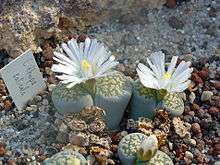Lithops salicola
| Lithops salicola | |
|---|---|
 | |
| Scientific classification | |
| Kingdom: | Plantae |
| Clade: | Angiosperms |
| Clade: | Eudicots |
| Order: | Caryophyllales |
| Family: | Aizoaceae |
| Genus: | Lithops |
| Species: | L. salicola |
| Binomial name | |
| Lithops salicola L.Bolus 1936 | |
Lithops salicola is a species of perennial plant in the Aizoaceae family, often called living stones.[1]
Description
Lithops salicola has two coupled leaves, divided by a fissure through which the flowers appear. It is cylindrical or conical with a flat surface and green-gray coloration. Their flowers are white and very small.[2][3] It grows to a height of .02 metres (0.79 in).[1]
Distribution
This species can be found in Namibia and South Africa at an altitude of 1,000 metres (3,300 ft) to 1,350 metres (4,430 ft). They are generally found in well-drained soil or in rock crevices. It occurs in an area of summer rainfall.
Cultivation
It is commonly used as a houseplant or for landscaping. Like all Lithops, it requires extremely well-drained soil. Like all Lithops it also grows in annual cycles, as the leaf-pairs flower, and then each produces a new leaf-pair that replaces the old one (which shrivels away). The principal rule of watering is that Lithops should be kept dry from when they finish flowering, up until the old leaf-pairs are fully replaced.
Of the Lithops species, L. salicola is one of the species which is most tolerant of occasional incorrect watering, and therefore among the easiest to cultivate (together with L. lesliei, L. hookeri and L. aucampiae).[4][3]
In the United Kingdom L. salicola has gained the Royal Horticultural Society’s Award of Garden Merit.[5][6]
References
| Wikispecies has information related to Lithops salicola |
| Wikimedia Commons has media related to Lithops salicola. |
- 1 2 African Plant Database
- ↑ "Lithops salicola L. Bol. (1936)". Lithops species. Retrieved 19 January 2014.
- 1 2 1997 IUCN red list of threatened plants
- ↑ "Lithops salicola C351 TL: 10 km W of Luckhoff, South Africa cv. Malachite". Encyclopedia of living forms. Retrieved 19 January 2014.
- ↑ "RHS Plantfinder - Lithops salicola". Retrieved 25 March 2018.
- ↑ "AGM Plants - Ornamental" (PDF). Royal Horticultural Society. July 2017. p. 61. Retrieved 25 March 2018.